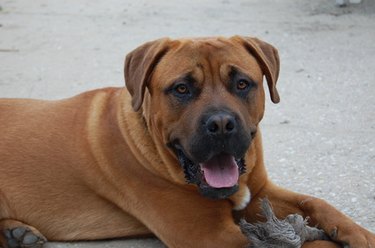Tip
Observe your dog closely. Shoulder dysplasia can get worse or better, and the more you know about your dog's condition, the more prepared you will be to take action.

In dogs, shoulder dysplasia usually takes the form osteochondrosis, where the cartilage of the joint is deficient. This leads to the surface of a joint being uneven and if this is something that is affecting your dog, understanding how to treat this condition is an important part of responsible pet ownership. According to the American College of Veterinary Surgeons, this condition is common in the shoulders of immature, large and giant-breed dogs.
Step 1
Consult with your veterinarian. Many large dogs will develop signs of this disorder between the ages of 4 and 8 months. If it is caught at this early stage, only minor surgery might be necessary. If the condition is not detected until later in the dog's life, major surgery might be required to fix it and to ensure that your dog retains his mobility.
Video of the Day
Step 2
Exercise your dog carefully. One of the ways that many owners notice something is amiss is that their dog starts limping after prolonged exercise. If the dog gets too much exercise, she may weaken her shoulder further. Although your dog might want to play more, she should be restrained so that she does not overextend herself.
Step 3
Feed your dog a lean diet. Dogs who suffer from shoulder dysplasia can become overweight due to lack of activity, and additional weight can put more stress on the joint. To combat that, look for pet food that is lower in fat. You may wish to ask your veterinarian for advice on which foods your dog should be eating.
Step 4
Apply heat to the weakened shoulder. Due to the deformation of the shoulder joint, it can become inflamed, and heat can bring your dog some pain relief. A heating pad can help, as can a hot water bottle, although dogs tend to chew on the later. You can also microwave a towel and apply it to the aching shoulder.
Step 5
Administer anti-inflammatory medication. As your dog ages, there is a very good chance that his shoulder dysplasia will get worse. A condition that might have been kept in check with exercise when your dog was a puppy might reach a point where medication is necessary. This medication is typically administered in capsule form and can be swallowed whole or sprinkled into your dog's food.
Always check with your veterinarian before changing your pet’s diet, medication, or physical activity routines. This information is not a substitute for a vet’s opinion.
Video of the Day